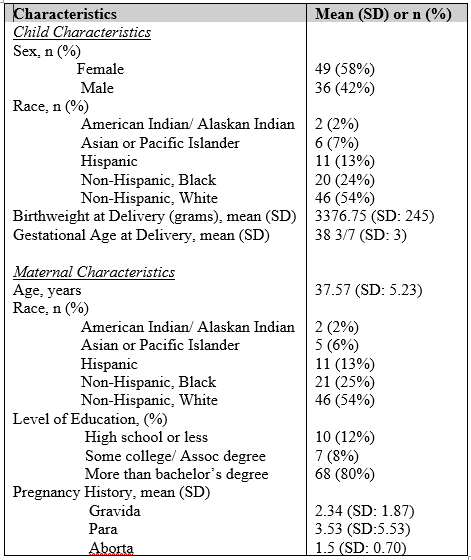Developmental and Behavioral Pediatrics: Parenting
Developmental and Behavioral Pediatrics 5
684 - Maternal stress in pregnancy predicts infant neurodevelopmental outcomes
Publication Number: 684.307

Madison Myers, MSc (she/her/hers)
Clinical Research Coordinator
Children's National Health System
Washington, District of Columbia, United States
Presenting Author(s)
Background:
High stress during pregnancy has been demonstrated to impact the fetus and pose long-term neurodevelopmental and behavioral consequences. However, the mechanisms through which prenatal maternal stress may impact the developing child are still largely unknown. Maternal stress levels captured during the prenatal period may give foresight to long-term implications towards the cognitive and social-emotional development of offspring.
Objective:
This study aimed to examine whether maternal prenatal stress levels during pregnancy can be used as a predictor to determine longitudinal child neurobehavioral outcomes at the twelve-month developmental timepoint.
Design/Methods: We enrolled healthy pregnant women with uncomplicated, singleton gestations into a prospective, longitudinal study where they completed a series of validated mental distress scales during the prenatal period. Specifically, the Spielberger State-Trait Anxiety Inventory, and the Perceived Stress Scale (PSS) was utilized to measure anxiety levels. The Warner Initial Developmental Evaluation of Adaptive and Functional Skills (WIDEA-FS), an activity criterion checklist for infants and toddlers was completed at the twelve-month time point. Multiple linear regression was used to determine the degree to which maternal distress scores during the fetal period were associated with neurodevelopmental scores.
Results: We studied 85 mother-baby dyads. Maternal caregivers completed stress questionnaires in the prenatal period and responded to the WIDEA-FS developmental questionnaire when their child was twelve-months of age (Table 1). A multiple regression analysis was run to predict twelve-month neurodevelopmental outcomes from the maternal distress scores completed during the fetal period (Table 2). The three-predictor model of maternal distress scores was able to account for 28.5% of the variation in twelve-month neurodevelopmental outcomes F (3,20) = 2.65, p < .05. Maternal STAI State Anxiety significantly predicted neurodevelopmental outcomes (β = 0.96, p < .05), as well as the PSS (β = 1.14, p < .05). However, STAI Trait anxiety was not significantly associated with child neurodevelopmental outcomes (p > .05).
Conclusion(s): This study demonstrates that prenatal exposure to maternal stress is significantly associated with neurodevelopmental outcomes in early childhood. Further research is warranted to better understand the effects of maternal stress during the fetal period on child neurodevelopment. These findings will be critical in developing interventions that support pregnant women’s emotional and psychological health during pregnancy and beyond. 

